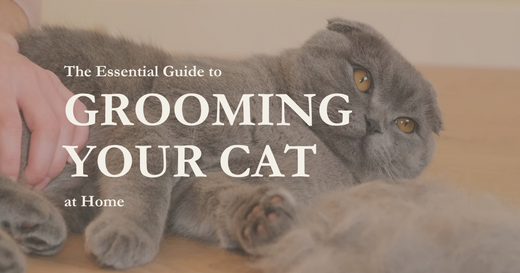Grooming is an essential aspect of cat care that not only keeps your feline friend looking their best but also plays a crucial role in their overall health and well-being. While cats are known for their self-grooming abilities, regular grooming sessions at home are still necessary to address areas that they may miss and to strengthen the bond between you and your pet. In this comprehensive guide, we'll delve into why grooming is important for cats, the essential tools you'll need for at-home grooming, how often your cat needs to be groomed, and tips for creating a stress-free grooming experience for both you and your furry companion.
Why Cats Need Regular Grooming
While cats are meticulous self-groomers, they still require regular grooming from their human companions for several reasons. Regular grooming helps to remove loose fur, dirt, and debris from their coat, preventing matting and reducing the risk of hairballs. Additionally, grooming allows you to check for any signs of skin problems, parasites, or injuries that may require veterinary attention. Beyond their coat, grooming also encompasses nail trimming, ear cleaning, dental care, and occasional bathing to ensure your cat's overall health and hygiene are maintained.
Essential Grooming Tools for Grooming Cats at Home
When it comes to grooming your feline friend at home, having the right tools is essential for keeping your cat's coat healthy and their overall well-being in check. Let's explore the must-have grooming tools and why they're indispensable for every cat owner:
1. Slicker Brush
Slicker brushes have fine, wire bristles that effectively remove loose fur, tangles, and mats from your cat's coat. Regular brushing with a slicker brush helps prevent hairballs, reduces shedding, and stimulates circulation to promote a healthy skin and coat.
2. Pin Brush
Ideal for cats with longer, thicker coats, a pin brush features widely spaced, rounded metal pins that glide through the fur without causing discomfort. Pin brushes are perfect for gently detangling knots, removing debris, and distributing natural oils for a shiny, lustrous coat.
3. Nail Clippers
Trimming your cat's nails is crucial for maintaining their nail health and preventing painful overgrowth, ingrown nails, and accidental scratches. Cat-specific nail clippers or nail trimmers are designed with safety in mind, ensuring you can trim your cat's nails with precision and confidence.
4. Straight Comb
A straight comb is invaluable for smoothing and detangling your cat's fur, particularly in areas prone to matting such as behind the ears and along the back. Its long teeth penetrate deep into the coat to remove knots and debris, promoting a sleek, well-groomed appearance.
5. Fine-Toothed Comb
This specialised comb features fine teeth designed to catch and remove fleas, flea eggs, and flea dirt from your cat's coat. Additionally, a fine-toothed comb effectively removes loose fur and reduces shedding, keeping your cat comfortable and your home free from pesky pests. Moreover, it can be used to delicately remove debris from your cat's face, such as dried eye gunk or food stuck to their chin, keeping a clean and hygienic appearance.
How Often Should You Groom Your Cat
The frequency of grooming sessions will vary depending on your cat's fur length and type. For short-haired cats, aim to brush them once or twice a week, while medium-haired cats benefit from brushing sessions 2-3 times a week. Long-haired cats require more frequent brushing, ideally 3-4 times a week, to prevent mats and tangles. Bathing for short-haired cats can be done every 2-3 months, while medium-haired cats can be bathed every 1-2 months. Long-haired cats should be bathed every 4-6 weeks to maintain a clean coat.
Additionally, incorporate nail trims and ear cleanings into your cat's routine every 2-4 weeks to maintain their overall health and well-being. Also, be sure to brush your cat's teeth daily for optimal oral hygiene or as recommended by your vet.
Tips for a Stress-Free Grooming Experience at Home
Grooming sessions can be an opportunity for bonding between you and your cat, but they can also be stressful if not approached with care. To ensure a positive grooming experience, create a calm and comfortable environment free from distractions. Introduce grooming gradually and use positive reinforcement techniques such as treats and praise to reward good behaviour. Take breaks if your cat becomes stressed or agitated, and never force them to continue if they're uncomfortable. With patience, consistency, and plenty of love, grooming can become a cherished ritual for both you and your beloved feline companion.
Step-by-Step Guide to Grooming Your Cat at Home
Brushing Your Cat at Home
Short-haired and medium-haired cats benefit from a slicker brush, while long-haired cats require a pin brush and a wide-toothed straight comb to prevent matting. Start by gently brushing your cat's fur in the direction of hair growth. Be particularly thorough around the neck, belly, and tail where knots tend to form. Many cat owners only reach the surface hairs on their cats. Don’t be afraid to gently push back the hairs and get down to the roots, especially for medium and long-haired cats.
Bathing Your Cat at Home
Bathing your cat can be a daunting task, but with the right approach, it can become a manageable part of your grooming routine. Start by gathering all your supplies, including a cat-specific shampoo to maintain your cat's skin and coat health without stripping away natural oils. Dilute the shampoo with water to ensure it's gentle on your cat's skin. Before bathing, make sure the water is lukewarm, as water that is too hot or too cold can be uncomfortable for your feline friend. Using a handheld sprayer or a cup, wet your cat's fur thoroughly, avoiding their ears and eyes.
When it's time to apply the shampoo, gently massage it into your cat's fur, focusing on areas that are particularly dirty or oily. Take care to avoid getting water or soap in your cat's ears and eyes, as this can cause discomfort and irritation. For cats who are scared of water, consider using a sink or shallow basin instead of a bathtub, as this can help them feel more secure.
If your cat is particularly fearful of bathing, start by introducing them to water gradually. Offer treats and praise to create positive associations with the bathing process. Additionally, consider using a grooming hammock or towel wrap to help restrain your cat safely during the bath, ensuring both you and your cat remain calm and comfortable throughout the experience.
After bathing, thoroughly rinse out all the shampoo, making sure no residue is left behind. Use a soft towel to pat your cat dry, and allow them to air dry in a warm room. For medium to long-haired cats, consider putting them in their carriers with ventilation and gently blow dry them with a hairdryer on low to speed up the process. Once your cat is fully dried, brush their coats to ensure that they are tangle-free. With patience and practice, bathing your cat can become a stress-free experience for both you and your furry friend.
Trimming Your Cat’s Nails at Home
Nail trimming is a crucial aspect of cat grooming to prevent overgrowth and maintain your cat's nail health. Start by investing in quality cat nail clippers or trimmers that are specifically designed for feline nails. Guillotine-style clippers work well for small to medium-sized nails, while scissor-style trimmers are better suited for larger nails.
When trimming your cat's nails, gently hold their paw and press on the pad to extend the nails. Use caution to avoid cutting into the pink area known as the quick, which contains blood vessels and nerves. Trim only the sharp tip of each nail to prevent discomfort or injury to your cat.

It's recommended to trim your cat's nails every 2-4 weeks, depending on their rate of growth. If your cat is anxious or fearful of nail trimming, try introducing them to the process gradually and associate it with positive experiences such as treats and praise.
For particularly nervous cats, consider seeking assistance from a professional groomer or veterinarian. Additionally, you can try trimming just a few nails at a time to gradually acclimate your cat to the process. With patience and positive reinforcement, nail trimming can become a stress-free and routine part of your cat's grooming regimen.
Cleaning Your Cat’s Ears at Home
Cleaning your cat's ears is an important part of their grooming routine to maintain hygiene and prevent infections. Start by selecting a cat-specific ear cleaning solution to help dissolve ear wax and kill bacteria. Avoid using cotton swabs or inserting anything into your cat's ear canal, as this can cause injury and discomfort.
To clean your cat's ears, moisten a cotton ball with the cleaning solution and gently wipe the outer ear flap and the visible part of the ear canal. Be careful not to go too deep into the ear canal, as this can damage the delicate structures inside. If your cat is anxious or fearful of ear cleaning, try associating the process with positive experiences by offering treats and praise.
It's important to clean your cat's ears regularly, ideally every 2-4 weeks, to remove excess wax and debris and prevent ear infections. Watch for signs of discomfort, such as scratching or head shaking, which may indicate an underlying issue that requires veterinary attention. By following these tips and techniques, you can help keep your cat's ears clean and healthy, ensuring their overall well-being and comfort.
Brushing Your Cat’s Teeth at Home
Teeth brushing is an essential component of cat grooming to prevent dental issues and maintain your cat's oral health. Start by selecting a cat-specific toothpaste in a flavor your cat enjoys, such as poultry or seafood. It's important to never use human toothpaste, as it can contain ingredients that are toxic to cats.
Next, choose a soft-bristled toothbrush or a finger brush designed for cats. Allow your cat to taste the toothpaste to get them accustomed to the flavour before beginning the brushing process.
To brush your cat's teeth, gently lift their lips and brush their teeth using small circular motions. Focus on the outer surfaces of the teeth, paying extra attention to the back molars where plaque tends to accumulate.
It's recommended to aim for daily teeth brushing sessions, or as recommended by your veterinarian, to prevent tartar buildup and maintain oral hygiene. Be patient and consistent, offering praise and rewards to make the experience positive for your cat.
When holding your cat for teeth brushing, it's important to approach them calmly and gently. Securely hold your cat's body with one hand while using the other hand to lift their lips and brush their teeth. If your cat becomes anxious or resistant, take breaks and offer reassurance to help them feel more comfortable. Gradually increase the duration of teeth brushing sessions as your cat becomes more accustomed to the process.
Conclusion
Grooming your cat at home is not only essential for their physical health and well-being but also strengthens the bond between you and your beloved pet. By understanding the importance of grooming, having the right tools, and following step-by-step techniques, you can ensure a stress-free grooming experience for both you and your furry friend. Regular grooming sessions allow you to monitor your cat's overall health, address potential issues early on, and provide them with the care and attention they deserve. With patience, consistency, and love, grooming can become a rewarding and enjoyable aspect of cat ownership, contributing to a lifetime of health and happiness for your feline companion.

